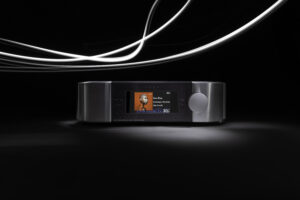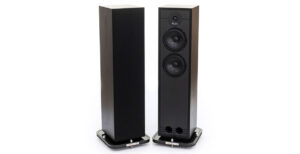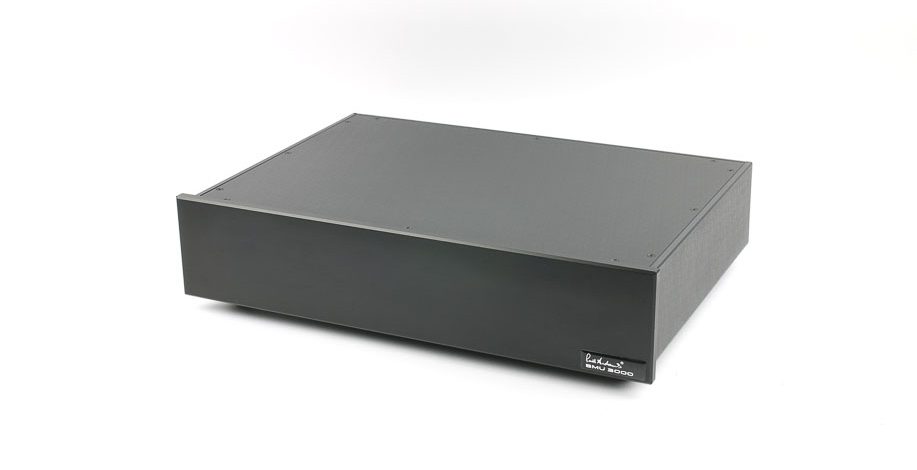
The Russ Andrews BMU 3000 Mk II – like the Connected Fidelity AC-2K – is a balanced mains transformer. Instead of a Live wire at around 240 V AC and Neutral at or close to ground potential, in the BMU Live and Neutral are reset by a transformer to +120 and –120 V, relative to earth. Similar to balanced audio feeds using three-wire XLR connections, using two power lines mirrored about a central earth provides common-mode noise rejection.
The first BMU (Balanced Mains Unit) was launched in 2008, designed and built for Russ Andrews by transformer expert Paul Houlden and built around a massive 3000 VA toroidal transformer. This was housed in a metal box with two UK mains outlets. In 2018 the BMU was replaced by the Mk II, still using Houlden hand-finished toroids but with the Russ Andrews Accessories company assembling the finished unit, now in a lower-profile case.
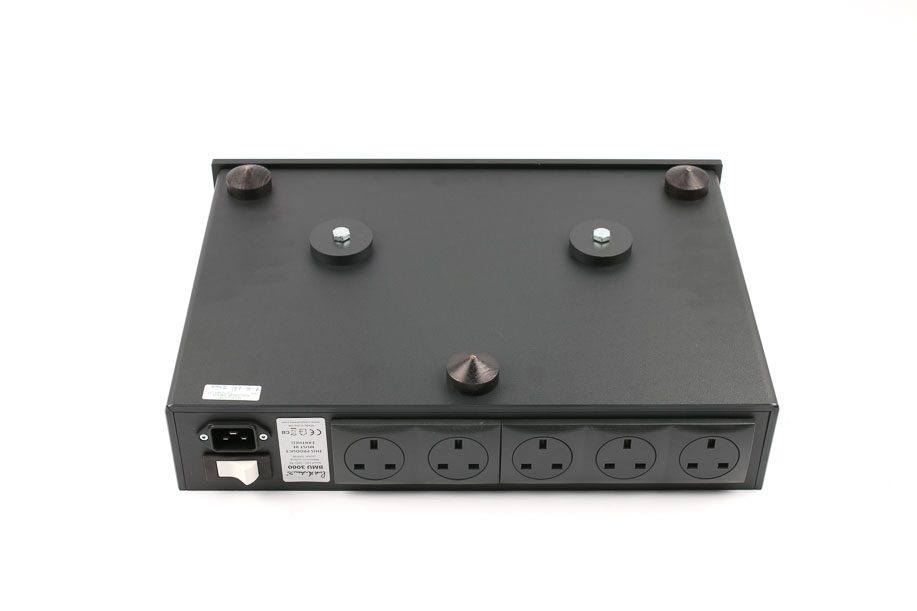
In total three versions are currently available: the entry-level uses a single 1500 VA toroid, while the unit reviewed here has two such transformers wired in parallel, for an overall rating of 3000 VA. The black all-ABS cabinet is the same between these two models. For the larger 3000 model, the toroidal transformers fit side-by-side.
Filters
Besides the new box, the Mk II adds mains filtering, placed before the transformers. Wired across the IEC inlet, this is also sold separately as the DIY RA Silencer, and is designed to remove mains noise. It’s listed as a passive differential and common-mode inductorless non-resonant harmonic filter. Although not essential, the company recommends it is serviced every five years.
Across the back panel are five UK mains outlets in the form of RA’s custom-made UltraSockets. These are deep cryogenically treated and finished with DeoxIT contact enhancer, and are mounted inverted, to help wiring when the unit is sited close to the ground. Kimber Kable is listed for internal wiring, although this is only used to wire together the mains outlets, daisy-chained, including the earth connections.
A third version of the BMU is the Install version, also rated at 3000 VA with two transformers, only in a metal dust-proof cabinet without three-pin outlets or filters. As the name suggests, this is designed for permanent hard-wired installation, typically as part of a dedicated spur from the consumer unit to the system.
All units include two forms of safety feature. Thermal fuses are built into the toroids should they suffer a catastrophic short, and will trip when internal temperature rises above 90°C. And a magnetic circuit breaker (MCB) is fitted into the power switch attached to the back panel. This switch is wired from the secondary side of the transformer, meaning the transformers are always ‘on’ regardless of switch setting. The MCB cuts power in the event of a fault on the mains wiring.
Tap talk
After ordering and before delivery, RA Accessories sends a digital voltmeter to the customer in order for them to check local line voltage. According to the company, ‘each Balanced Mains Unit can be set so that it matches your incoming voltage. This is very important to minimise excessive transformer noise. The custom transformers are incredibly efficient so if a higher or lower than average voltage is fed to them, this can be converted to mechanical noise within the transformers’.
OEM maker Paul Houlden told me that taps are used enable output to be adjusted, such that a customer receiving 220 V could raise this to 235 V, for example. Or, conversely, a ‘hot’ incoming level of 250 V could be dialled down. Adjustments are possible using a combination of taps on the transformer primary windings.

The taps used to be user-adjustable, with owners able to try up to four settings by connecting together different colour-coded wire taps from the torus until they found a match producing the lowest hum.
Hands on
After taking readings over a few days, it was confirmed that my house receives a nominal 240 V, and the review sample was duly shipped. Measuring the unit’s output showed a typical 4 V drop, to 236 V, suggesting it may be configured as exactly 1:1, allowing for a 2% loss through the transformers, which would agree with the circa-98% efficiency figure quoted by the maker.
There is no surge protection or soft-start mechanism, and on several occasions it tripped the RCD in the consumer unit. The new Mk II features re-designed internal transformers with the result said to be quieter operation and more efficiency than before. In practice, the transformers – hard-mounted to the chassis on a thin sandwich of foam – were often audible. This was not a constant noise, but was relate to mains quality.
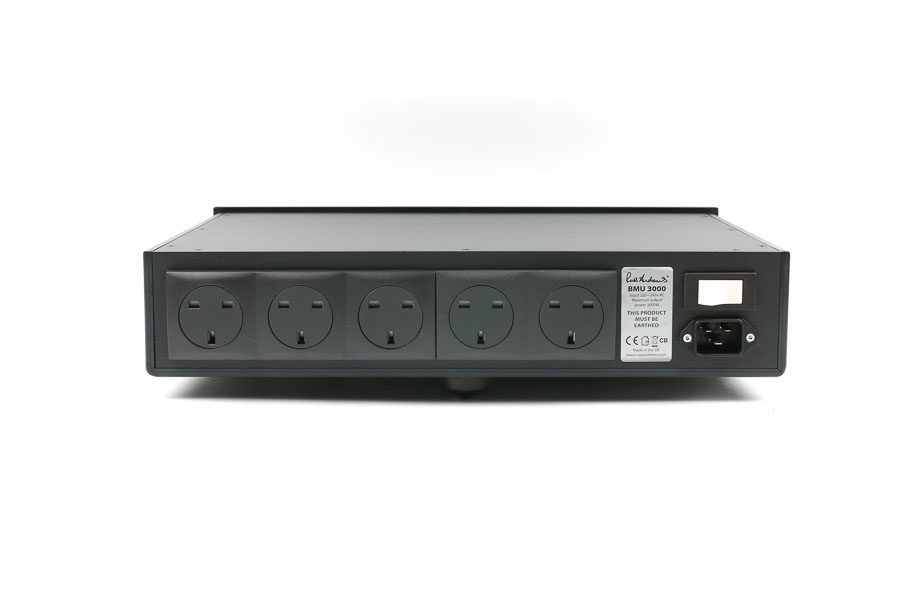
The rattly buzz, comprising mainly 100 Hz plus a long tail of harmonics, would slowly rise and fall in volume, at peak loud enough to be heard not just in the gaps between music but over the music too, from across the room. To test for stray DC on the mains, I wired in-line an Audiolab DC Block 6, which cured the buzzing immediately. And to test if this phenomenon was localised in my home, I tried a neighbour’s supply in the same building, running from a different leg of the national grid three-phase supply. The noise was identical. However, while an obvious solution might be to a add DC-blocking capacitor, Russ says it affects musicality. As the AC-2K (which was always silent), ripened the bass in a way the neutral BMU 3000 Mk II did not, he may have a point.
Sound
Without doubt, the sound quality from the system while using the BMU 3000 Mk II improved palpably. One is tempted to say that it is ‘transformative’. As I discovered with the Connected Fidelity AC-2K, there was a relaxation effect, with instrumentation sounding smoother, more natural and flowing. Stereo space became holographic. It’s that feeling of calm, like stepping into a soundproofed room deprived of daily ambient noise.
Various permutations of connection were tried using the BMU powering either the whole system, just the source components, or just the power amplifier. Perhaps the most satisfying was with an Evolution-300 PowerKord from wall socket to the BMU, feeding the power amp, and phono stage wired straight to wall. In all settings however, the BMU 3000 Mk 2 was less colored, and better able to preserve the slam and pace found with a direct wall connection.
Conclusion
In conversation with Paul Houlden, his worst hum-related complaints have been from customers living in London, which may have particular issues with grid DC. Unfortunately it’s not always trivial to fix, so a BMU may not be viable for someone in affected areas. While the BMU can show a staggering subjective improvement in perceived playback ‘hush’, paradoxically it can introduce an intolerable level of mechanical noise. Another solution could be the Install version, sited in a distant cupboard.
Russ Andrews Accessories offers a 60-day money back guarantee on its products, and on that basis it’s easy to recommend a trial to gauge first whether you’re unfortunate enough to encounter hum issues in your neighbourhood. If all is clear, the product should then sell itself.
Price and contact details
Product prices
- BMU 3000 Mk II, £4,559
- BMU 1500 Mk II £3,059
- BMU 3000 Install £4,150
Manufacturer
Russ Andrews Accessories Ltd
+44(0)1539 797300
Tags: BALANCED MAINS TRANSFORMER RUSS ANDREWS BMU 3000 MK II
By Andrew 'Harry' Harrison
More articles from this authorRead Next From Review
See all
PrimaLuna EVO 100 phono preamplifier
- Apr 22, 2024

Reiki Audio SuperSwitch Master Pro + Servant Pro
- Mar 27, 2024

Melco Audio N1-S38 music server
- Mar 27, 2024








